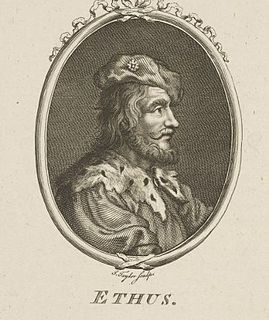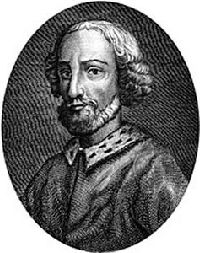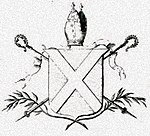Related Research Articles

Áed mac Cináeda was a son of Cináed mac Ailpín. He became king of the Picts in 877, when he succeeded his brother Constantín mac Cináeda. He was nicknamed Áed of the White Flowers, the wing-footed or the white-foot.
Máel Coluim mac Domnaill was king of Alba, becoming king when his cousin Constantine II abdicated to become a monk. He was the son of Donald II.
Cináed mac Maíl Coluim was King of Scots (Alba). The son of Malcolm I, he succeeded King Cuilén on the latter's death at the hands of Rhydderch ap Dyfnwal in 971.
Donald III, and nicknamed "Donald the Fair" or "Donald the White", was King of Scots from 1093–1094 and 1094–1097.

Cináed mac Duib, anglicised as Kenneth III, and nicknamed An Donn, "the Chief" or "the Brown", was King of Scots from 997 to 1005. He was the son of Dub. Many of the Scots sources refer to him as Giric son of Kenneth son of Dub, which is taken to be an error. An alternate explanation is that Kenneth had a son, Giric, who ruled jointly with his father.
Domnall mac Causantín, anglicised as Donald II, was King of the Picts or King of Alba in the late 9th century. He was the son of Constantine I. Donald is given the epithet Dásachtach, "the Madman", by the Prophecy of Berchán.
The Mormaerdom or Kingdom of Moray was a lordship in High Medieval Scotland that was destroyed by King David I of Scotland in 1130. It did not have the same territory as the modern local government council area of Moray, which is a much smaller area, around Elgin. The medieval lordship was in fact centred on both the lower Spey valley and the environs of Inverness and the northern parts of the Great Glen, and probably originally included Buchan and Mar, as well as Ross.
Máel Coluim of Moray was King or Mormaer of Moray (1020–1029), and, as his name suggests, the son of a Máel Brigte. As with his predecessor Findláech mac Ruaidrí, sources call him "King of Scotland."

The Bishop of St. Andrews was the ecclesiastical head of the Diocese of St Andrews and then, from 14 August 1472, as Archbishop of St Andrews, the Archdiocese of St Andrews.
Fothad II was the bishop of St Andrews (1059–1093) for most of the reign of King Máel Coluim III mac Donnchada. Alternative spellings include Fodhoch, Fothach and Foderoch, and Fothawch. A "Modach filius Malmykel" is mentioned in a grant, dated 1093, as the bishop of S. Andrews. As this bishop is certainly Fothad II, his father was a man named Máel Míchéil.
Cellach I is traditionally said to have been the first Bishop of the Scots, the bishopric later based at St. Andrews. He is mentioned in the historical writings of Walter Bower and Andrew of Wyntoun as a bishop of St. Andrews, but no pre-15th century sources say anything more than merely "Bishop". Wyntoun and Bower make him bishop as early as the reign of King Giric of Scotland (877x878-885x889). He was still bishop in the reign of King Causantín II of Scotland in 906 when, "in his sixth year king Causantín and bishop Cellach upon the hill of credulity near the royal city of Scone, pledged themselves that the laws and disciplines of the faith, and the rights in churches and gospels, should be kept in conformity with the [customs of the] Gaels". One interpretation of this passage is the demise of the "Pictish church" to the reforming Gaels, however it is certain that by the 15th century the bishop-list of the principal Scottish see was looking back at Cellach as its first bishop. His death date is unknown, but unsurprisingly he was certainly dead by the 960s when his successor Fothad I died as bishop.
Fothad I is the second alleged Bishop of the Scots (906x955). We know he had the status of "bishop" during the reign of King Dub mac Maíl Coluim because the Chronicle of the Kings of Alba has his death in the period of his reign (962-967). Such a date is supported by the Irish annals, and according to the Annals of the Four Masters, he died in 963. According to the latter source, he was Fothadh, mac Brain, scribhnidh & espucc Insi Alban; that is, "Fothad, son of Bran, scribe and bishop of the islands of Scotland". This entry taken on its own obviously places some doubt on his status as a bishop of St Andrews. It is only because he is mentioned as a bishop of St. Andrews in the bishop-lists of Walter Bower and Andrew of Wyntoun that he is identified with this see; however no pre-15th century sources actually confirm this, although it is true that there was definitely a bishop of this name in the 11th century. Bower, however, gives some explanation, telling us that Fothad "was driven out by King Indolff; and after his expulsion from the see he lived for 8 years". This Indolff, or King Idulb mac Causantín reigned between 954 and 962. If we take both Bower's statement and the obit reported in the Annals of the Four Masters to be correct, this means that Fothad was expelled in 955. Although it is unlikely anyway, he could not have been bishop before the year 906, when we know his predecessor Cellach was still bishop. That he died in 963 as "espucc Insi Alban" allows the possibility that he transferred his see to Iona or elsewhere on the western coast of Scotland after 955, although this is just conjecture.
Máel Ísu I is the third alleged Bishop of Cennrígmonaid, equivalent to latter day St Andrews. He is mentioned in the bishop-lists of the 15th-century historians Walter Bower (Malisius) and Andrew of Wyntoun (Malice) as the successor of Fothad I, and it is claimed that he reigned as bishop for eight years. If Máel Ísu's predecessor did get expelled from the bishopric in 955,, and if Máel Ísu's reign really was eight years, then Máel Ísu would have held the bishopric between the years 955 and 963.
Máel Muire is the fifth alleged bishop of St Andrews, though at that period the bishop of the Scots did not necessarily have one episcopal seat. He is mentioned in the bishop-list of the 15th-century historian Walter Bower as the successor of Cellach II, the latter of whom reign for at least 25 years. Nothing else is known about Máel Muire. However, he cannot have been bishop before 988/9, because that is the earliest likely date for the end of the episcopate of his predecessor Cellach. The next firm date for any bishop of the Scots is 1055, when the Annals of Tigernach records the death of bishop Máel Dúin, and obviously this date is too far ahead to be of very much use.
Máel Ísu II is the sixth alleged Bishop of the Scots, equivalent to latter day St. Andrews. He is mentioned in the bishop-lists of the 15th-century historians Walter Bower and Andrew of Wyntoun as the successor of Cellach II. We have no direct dates for Máel Ísu II's episcopate, but the indirect evidence for his predecessors suggests that he was bishop in the late 10th and/or early 11th century.
Ailín is the seventh alleged Bishop of St Andrews. He is mentioned in the bishop-lists of the 15th-century historians Walter Bower and Andrew of Wyntoun as the successor of Máel Ísu II. We have no direct dates for Ailín's episcopate, but the indirect evidence for his predecessors suggests that he was bishop in the early 11th century. Name occurs in Latin form as Alwinus, the form for the Anglo-Saxon name Ælfwine, although it may be a form for Alpín. A similar name, Alguine, occurs in the Book of Deer, and two Mormaers of Lennox had the name Ailín, similarly rendered as Alwinus.
Máel Dúin is the eighth alleged Bishop of St Andrews. He is mentioned in the bishop-lists of the 15th-century historians Walter Bower and Andrew of Wyntoun as the successor of Bishop Ailín.
Túathal is the ninth Bishop of St Andrews. He is mentioned in the bishop-list of the later medieval historian Walter Bower as the successor of Bishop Máel Dúin. Túathal's name, like his immediate predecessor Máel Dúin's, is known from other sources. A charter preserved in the Registrum of the Priory of St. Andrews, although probably translated into Latin from Gaelic at a later date, records a grant of the lands and church of Scoonie by Bishop Túathal (Tuadal) of St. Andrews to the Céli Dé of Loch Leven. Bower says that Túathal ruled as bishop for four years; as his successor Máel Dúin is known to have died in 1055, this would put his episcopate at roughly between the years 1055/6 and 1059/60. Túathal's immediate successor was the famous Bishop Fothad II.
Giric, if he is the Gregorius of Walter Bower, is the eleventh alleged Bishop of St Andrews. This Gregorius is mentioned in the bishop-list of Walter Bower as the successor of Bishop Fothad II. Bower's most recent editors commented that "there is no evidence to prove that any bishop of St Andrews was consecrated between 1093 and 1109". In the late 1990s, the University of Glasgow historian Dauvit Broun, by looking through the manuscripts afresh, recovered the previously unknown last 20% of Version-A of the St. Andrews Foundation Legend, a text composed at the turn of the 11th and 12th centuries. In it, a few of the contemporary church's leading men are named, and one of these is "Archbishop Giric".
Beóán of Mortlach is the first of the three known Bishops of Mortlach. His name, which could also be written in non-Gaelic contexts as Beanus, Beoanus and Beyn, means "lively one". Walter Bower, following John of Fordun, tells us that the bishopric was founded by king Máel Coluim II of Scotland in the seventh year of his reign as thanks to God for victories over the Scandinavians, and tells us that "the first bishop was Beyn, a saintly man, worthy of the episcopal office, elevated to this see by the Lord Pope Benedict VIII at the king's request". The Aberdeen Registrum records a charter granted to Bishop Beóán by King Máel Coluim at Forfar, granting the bishop the churches and lands of Clova and the unidentified Dulmech. The Aberdeen Breviary commemorated "Bishop Beóán" as a saint on 26 October. Another Beóán, perhaps the one mentioned in the Life of St. Cathróe of Metz, was commemorated on 16 December, and the two were often confused.
References
- Anderson, Alan Orr, Early Sources of Scottish History: AD 500–1286, 2 Vols, (Edinburgh, 1922), vol. i
- Anderson, Marjorie O., Kings and Kingship in Early Scotland, (Edinburgh, 1973)
- MacQueen, John, MacQueen, Winifred & Watt, D.E.R. (eds.), Scottichronicon by Walter Bower in Latin and English, Vol. 3, (Aberdeen, 1995)
